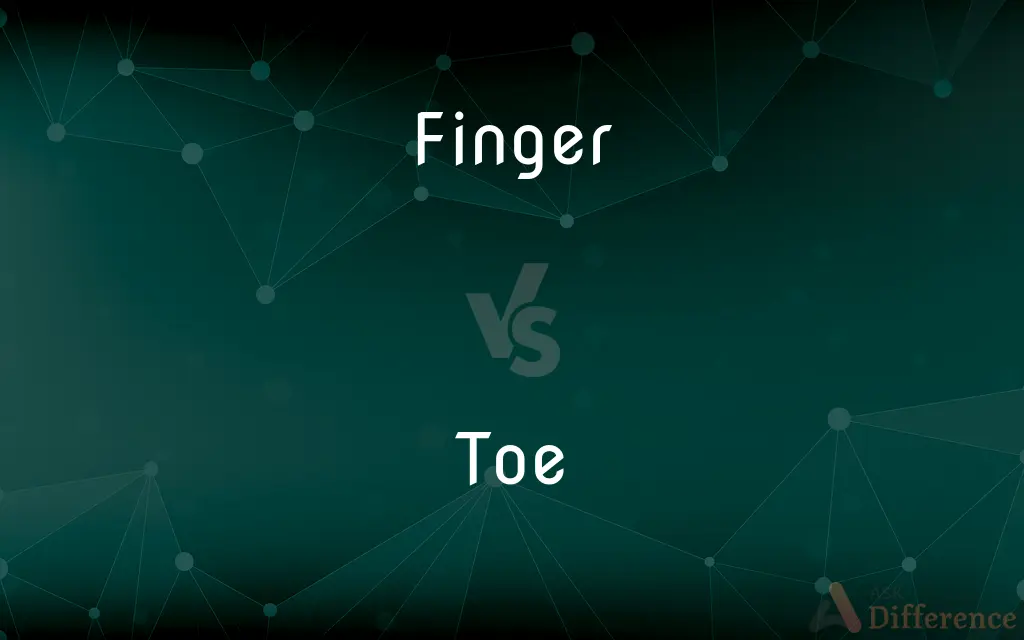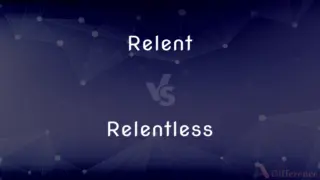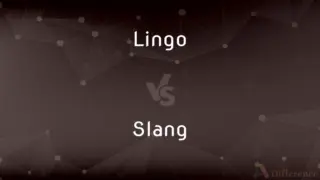Finger vs. Toe — What's the Difference?
Edited by Tayyaba Rehman — By Urooj Arif — Updated on April 3, 2024
Fingers are located on the hands and are primarily used for grasping and manipulation, while toes are on the feet and support balance and walking.

Difference Between Finger and Toe
Table of Contents
ADVERTISEMENT
Key Differences
Fingers are part of the human hand, consisting of five digits including the thumb, used for gripping, manipulation, and sensory detection. Toes, on the other hand, are located on the feet, consisting of five digits on each foot, playing a crucial role in maintaining balance, supporting weight, and enabling walking and running.
The structure of fingers allows for a wide range of motion and dexterity, facilitating complex tasks such as writing and tool usage. Whereas toes have a more limited range of motion but are essential for stabilizing the body during movement, contributing to our ability to stand upright and move efficiently.
Fingers possess a high concentration of nerve endings, making them highly sensitive to touch, temperature, and pain, which is vital for tactile feedback and manipulation of objects. In contrast, toes, while also sensitive, are primarily designed to withstand the stresses of weight bearing and contribute to proprioception, or the sense of body position.
In terms of anatomy, each finger is made up of three phalanges (bones), except for the thumb, which has two. Toes also consist of phalanges, with the big toe mirroring the thumb’s two-phalange structure, and the rest having three, reflecting a similar but not identical anatomical layout.
Fingers play a significant role in communication (e.g., sign language, gestures) and art (e.g., playing musical instruments). Toes, while less involved in these activities, are crucial for athletic performance, including running, jumping, and maintaining posture in various sports.
ADVERTISEMENT
Comparison Chart
Location
Hands
Feet
Function
Grasping, manipulation, sensation
Balance, walking, supporting body weight
Range of Motion
High, facilitating complex movements
Limited, mainly for stability
Anatomy
3 phalanges each (except thumb with 2)
3 phalanges each (except big toe with 2)
Sensitivity
High concentration of nerve endings for tactile sensitivity
Less sensitive, designed for weight bearing
Cultural Role
Important in communication and art
Less prominent, but essential in sports and balance
Compare with Definitions
Finger
Involved in fine motor skills.
Writing neatly demands precise finger coordination.
Toe
A digit located on the foot, aiding in balance and movement.
She wiggled her toes in the sand.
Finger
Contains nerve endings for touch sensitivity.
His fingers could feel the slightest texture change.
Toe
Less sensitive compared to fingers, suited for support.
Toes endure considerable pressure while walking.
Finger
Plays a crucial role in human dexterity.
Playing the piano requires great finger agility.
Toe
Big toe plays a significant role in maintaining equilibrium.
Losing a big toe can affect one's balance severely.
Finger
A digit on the hand used for gripping and manipulation.
She used her fingers to tie a knot.
Toe
Supports the body’s weight during walking and running.
His toes gripped the ground with each step forward.
Finger
Essential for non-verbal communication.
Sign language is primarily based on finger movements.
Toe
Critical for athletic performance.
Sprinters rely on their toe strength for a powerful start.
Finger
A finger is a limb of the human body and a type of digit, an organ of manipulation and sensation found in the hands of humans and other primates. Normally humans have five digits, the bones of which are termed phalanges, on each hand, although some people have more or fewer than five due to congenital disorders such as polydactyly or oligodactyly, or accidental or intentional amputations.
Toe
Toes are the digits (fingers) of the foot of a tetrapod. Animal species such as cats that walk on their toes are described as being digitigrade.
Finger
One of the five digits of the hand, especially one other than the thumb.
Toe
One of the digits of a vertebrate foot.
Finger
The part of a glove designed to cover a finger.
Toe
The forepart of a foot or hoof.
Finger
Something, such as an oblong peninsula, that resembles one of the digits of the hand.
Toe
The terminal segment of an invertebrate's limb.
Finger
The length or width of a finger.
Toe
The part of a sock, shoe, or boot that covers the digits of the foot.
Finger
A degree of participation; a share
"seems almost sure to have a finger or two in crafting the final blueprint" (George B. Merry).
Toe
The part of the head of a golf club farthest from the shaft.
Finger
An obscene gesture of defiance or derision made by pointing or jabbing the middle finger upward. Often used with the.
Toe
The part of a vertical shaft that turns in a bearing.
Finger
To touch with the fingers; handle.
Toe
The lowest part of an embankment or dam.
Finger
To mark (a score) with indications of which fingers are to play the notes.
Toe
(Geology)A protruding downslope end of an alluvial fan, glacier, or lava flow.
Finger
To play (an instrument) by using the fingers in a particular order or way.
Toe
To touch, kick, or reach with the toe.
Finger
To identify as responsible for wrongdoing or a crime, especially to the police
Fingered the sales clerk as the thief.
Toe
To drive (a golf ball) with the toe of the club.
Finger
To identify or designate as being responsible
"An international team of scientists fingered [the fungus] as the culprit in die-offs of 19 amphibian species" (Science News).
Toe
To set or adjust at an oblique angle. Used with in or out.
Finger
To handle something with the fingers.
Toe
To drive (a nail or spike) at an oblique angle.
Finger
(Music) To use the fingers in playing an instrument.
Toe
To fasten or secure with obliquely driven nails or spikes.
Finger
(anatomy) A slender jointed extremity of the human hand, (often) exclusive of the thumb.
Humans have two hands and ten fingers. Each hand has one thumb and four fingers.
Toe
To stand, walk, move, or be formed with the toes pointed in a specified direction
He toes out.
Finger
(zoology) Similar or similar-looking extremities in other animals, particularly:
Toe
Each of the five digits on the end of the foot.
Finger
The lower, smaller segment of an arthropod claw.
Toe
An equivalent part in an animal.
Finger
One of the supporting structures of wings in birds, bats, etc. evolved from earlier toes or fingers.
Toe
That part of a shoe or sock covering the toe.
Finger
One of the slender bony structures before the pectoral fins of gurnards and sea robins (Triglidae).
Toe
Something resembling a toe, especially at the bottom or extreme end of something.
Finger
Something similar in shape to the human finger, particularly:
Toe
(dance) An advanced form of ballet primarily for the females, dancing ballet primarily using a Pointe shoe.
Finger
(cuisine) Finger-shaped pieces of food.
Chocolate fingers; fish fingers; cheese fingers
Toe
(automotive) An alignment of the wheels of a road vehicle, either positive (toe in), meaning the wheels are closer together at the front than at the back, or negative (toe out), the other way round.
Finger
(chemistry) A tube extending from a sealed system, or sometimes into one in the case of a cold finger.
Toe
(engineering) The journal, or pivot, at the lower end of a revolving shaft or spindle, which rests in a step.
Finger
Syn of foxglove(D. purpurea).
Toe
(engineering) A lateral projection at one end, or between the ends, of a piece, such as a rod or bolt, by means of which it is moved.
Finger
Something similarly extending, (especially) from a larger body, particularly:
A finger of land; a finger of smoke
Toe
(engineering) A projection from the periphery of a revolving piece, acting as a cam to lift another piece.
Finger
(botany) Various protruding plant structures, as a banana from its hand.
Toe
(carpentry) The long side of an angled cut.
Finger
A lobe of the liver.
Toe
The upper end of the bit (cutting edge) of an axehead; as opposed to the heel (lower end).
Finger
(historical) The teeth parallel to the blade of a scythe, fitted to a wooden frame called a crade.
Toe
(slang) cameltoe
Finger
The projections of a reaper or mower which similarly separate the stalks for cutting.
Toe
To furnish (a stocking, etc.) with a toe.
Finger
(nautical) finger pier: a shorter, narrower pier projecting from a larger dock.
Toe
To touch, tap or kick with the toes.
Finger
(aviation) jet bridge: the narrow elevated walkway connecting a plane to an airport.
Toe
(transitive) To touch or reach with the toes; to come fully up to.
To toe the mark
Finger
(comptheory) A leaf in a finger tree data structure.
Toe
(construction) To fasten (a piece) by driving a fastener at a near-45-degree angle through the side (of the piece) into the piece to which it is to be fastened.
The framers toed the irregular pieces into the sill.
Finger
Something similar in function or agency to the human finger, (usually) with regard to touching, grasping, or pointing.
Toe
(golf) To mishit a golf ball with the toe of the club.
Finger
(obsolete) hand, the part of a clock pointing to the hour, minute, or second.
Toe
One of the terminal members, or digits, of the foot of a man or an animal.
Finger
A policeman or prison guard.
Toe
The fore part of the hoof or foot of an animal.
Finger
An informer to the police, (especially) one who identifies a criminal during a lineup.
Toe
Anything, or any part, corresponding to the toe of the foot; as, the toe of a boot; the toe of a skate.
Finger
A criminal who scouts for prospective victims and targets or who performs reconnaissance before a crime.
Toe
The journal, or pivot, at the lower end of a revolving shaft or spindle, which rests in a step.
Finger
(figurative) That which points; an indicator, as of guilt, blame, or suspicion.
The finger of suspicion pointed clearly at the hotel manager.
Toe
To touch or reach with the toes; to come fully up to; as, to toe the mark.
Finger
(historical) digitcm).
Toe
To hold or carry the toes (in a certain way).
Finger
(historical) digit the observed diameter of the sun or moon, (especially) with regard to eclipses.
Toe
One of the digits of the foot
Finger
An informal measure of alcohol based on its height in a given glass compared to the width of the pourer's fingers while holding it.
Gimme three fingers of bourbon.
Toe
The part of footwear that provides a covering for the toes
Finger
(fashion) A part of a glove intended to cover a finger.
Toe
Forepart of a hoof
Finger
Skill in the use of the fingers, as in playing upon a musical instrument.
Toe
(golf) the part of a clubhead farthest from the shaft
Finger
Someone skilled in the use of their fingers, (especially) a pickpocket.
Toe
Walk so that the toes assume an indicated position or direction;
She toes inwards
Finger
A person.
Toe
Drive obliquely;
Toe a nail
Finger
(especially in the phrase 'give someone the finger') An obscene or insulting gesture made by raising one's middle finger towards someone with the palm of one's hand facing inwards.
Toe
Hit (a golf ball) with the toe of the club
Finger
(radio) Any of the individual receivers used in a rake receiver to decode signal components.
Toe
Drive (a golf ball) with the toe of the club
Finger
(transitive) To identify or point out; to blame for something.
Toe
Touch with the toe
Finger
(transitive) To report to or identify for the authorities; to inform on.
Toe
Having a toe or toes of a specified kind; often used in combination;
Long-toed
Five-toed
Finger
(transitive) To poke, probe, feel, or fondle with a finger or fingers.
Finger
To use specified finger positions in producing notes on a musical instrument.
Finger
To provide instructions in written music as to which fingers are to be used to produce particular notes or passages.
Finger
To query (a user's status) using the Finger protocol.
Finger
(obsolete) To steal; to purloin.
Finger
To execute, as any delicate work.
Finger
One of the five terminating members of the hand; a digit; esp., one of the four extremities of the hand, other than the thumb.
Finger
Anything that does the work of a finger; as, the pointer of a clock, watch, or other registering machine;
Finger
The breadth of a finger, or the fourth part of the hand; a measure of nearly an inch; also, the length of finger, a measure in domestic use in the United States, of about four and a half inches or one eighth of a yard.
A piece of steel three fingers thick.
Finger
Skill in the use of the fingers, as in playing upon a musical instrument.
She has a good finger.
Finger
To touch with the fingers; to handle; to meddle with.
Let the papers lie;You would be fingering them to anger me.
Finger
To touch lightly; to toy with.
Finger
To perform on an instrument of music.
Finger
To take thievishly; to pilfer; to purloin.
Finger
To execute, as any delicate work.
Finger
To use the fingers in playing on an instrument.
Finger
Any of the terminal members of the hand (sometimes excepting the thumb);
Her fingers were long and thin
Finger
The length of breadth of a finger used as a linear measure
Finger
The part of a glove that provides a covering for one of the fingers
Finger
Feel or handle with the fingers;
Finger the binding of the book
Finger
Examine by touch;
Feel this soft cloth!
The customer fingered the sweater
Finger
Search for on the computer;
I fingered my boss and found that he is not logged on in the afternoons
Finger
Indicate the fingering for the playing of musical scores for keyboard instruments
Common Curiosities
Are there any similarities between fingers and toes?
Both fingers and toes have phalanges (bones) and are crucial for their respective functions in manipulation and balance.
Can toes sense touch like fingers?
Toes can sense touch but have fewer nerve endings than fingers, making them less sensitive.
How do toes help in walking?
Toes help in maintaining balance, supporting body weight, and propelling the body forward during walking.
Do fingers and toes have the same number of joints?
Yes, each finger and toe typically has three joints, except for the thumb and big toe, which have two.
How do fingers contribute to human communication?
Fingers are essential for gestures, sign language, and expressing emotions non-verbally.
Why are fingers more dexterous than toes?
Fingers have a higher range of motion and sensitivity, designed for complex tasks and manipulation.
How many bones are in a finger?
Most fingers have three bones (phalanges), except the thumb, which has two.
What is the significance of the big toe?
The big toe is crucial for balance and efficient walking, having a significant impact on posture and movement.
Can losing a toe affect your balance?
Yes, losing a toe, especially the big toe, can significantly affect balance and walking.
Is it possible to move toes as freely as fingers?
While some people can move their toes to a degree, they generally do not offer the same range of motion or dexterity as fingers.
What is the primary function of fingers?
Fingers are primarily used for gripping, manipulation, and sensitive touch.
How do fingers aid in human evolution?
Fingers played a crucial role in human evolution, allowing for tool use, which contributed to the development of complex societies.
Why are fingers more sensitive than toes?
Fingers have a higher concentration of nerve endings, making them more sensitive for detailed tactile feedback.
Are all toes the same length?
No, toe length varies, with some people having a longer second toe than the big toe, known as Morton's toe.
What role do toes play in athletic performance?
Toes are vital for balance, providing the necessary support and power in various sports.
Share Your Discovery

Previous Comparison
Relent vs. Relentless
Next Comparison
Lingo vs. SlangAuthor Spotlight
Written by
Urooj ArifUrooj is a skilled content writer at Ask Difference, known for her exceptional ability to simplify complex topics into engaging and informative content. With a passion for research and a flair for clear, concise writing, she consistently delivers articles that resonate with our diverse audience.
Edited by
Tayyaba RehmanTayyaba Rehman is a distinguished writer, currently serving as a primary contributor to askdifference.com. As a researcher in semantics and etymology, Tayyaba's passion for the complexity of languages and their distinctions has found a perfect home on the platform. Tayyaba delves into the intricacies of language, distinguishing between commonly confused words and phrases, thereby providing clarity for readers worldwide.















































